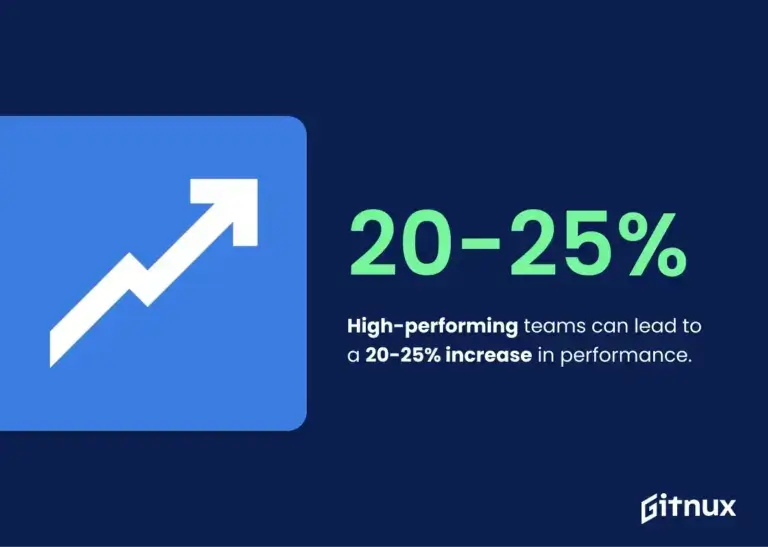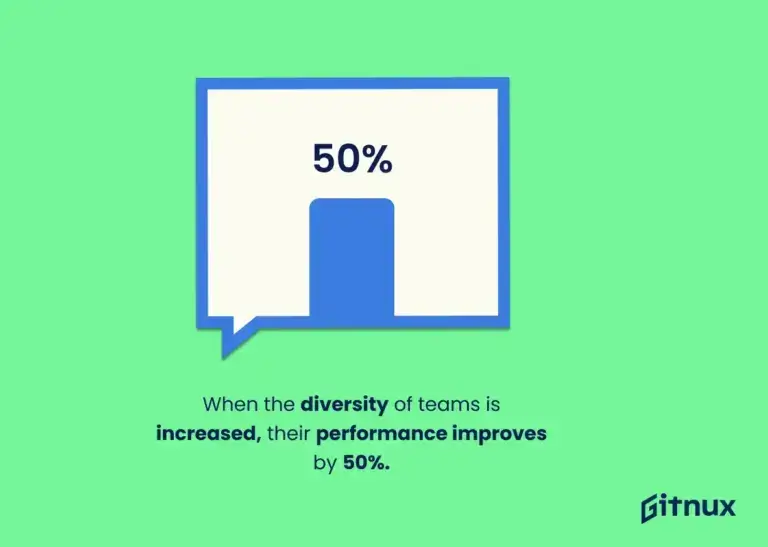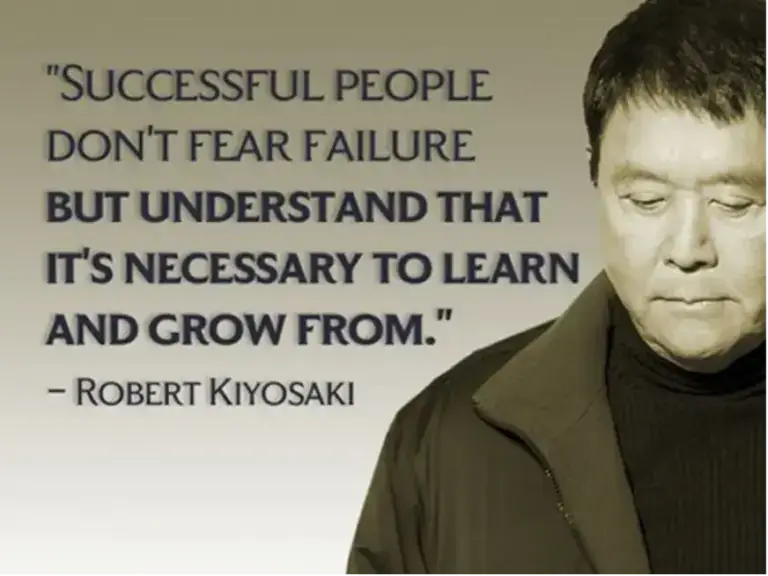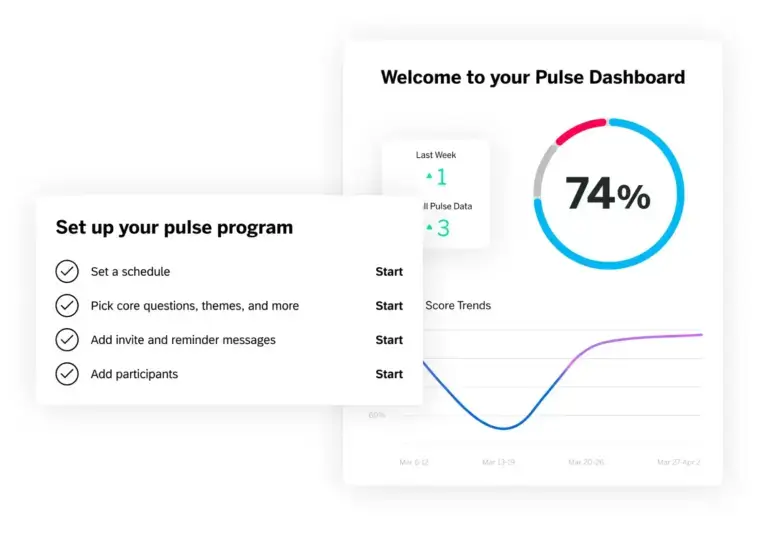Written by: Ruth D’Alessandro
Fact Checked by: Aaron Carpenter
In this article, we’re going to look at 8 features of high-performing teams, and 8 tips you can use to build them, harnessing the power of the latest EX technology to make business more human.
The 8 features of high-performing teams are:
- Clear purpose
- Diversity
- Communication
- Mutual accountability
- Embracing innovation and adaptability
- Using engaging processes and technology
- Collaborating across functions
- Recognizing and rewarding achievements
Let’s be real here. It’s challenging right now to build a fully functioning team, let alone a high-performing one. The post-pandemic world of work that blurred the line between work life and home life has left employees exhausted and burnt out, with many eager to reclaim boundaries and reshape their relationship with their jobs.
At the same time, hybrid working, global economic uncertainty, intergenerational differences and even geopolitical turmoil are all contributing to an unsettling climate of fragmentation and disconnection.
As a result, every industry and organization has had to revisit and re-evaluate their fundamentals to ensure they’re still relevant and capable of serving and meeting the expectations of their employees. From pay and benefits to wellbeing and development and everything between, employees are asking for more — and organizations are having to change the way they deliver.
After all, team performance is key to success and sustainability, and when leaders know and act on what their people need to operate at the best of their ability, they can drastically improve performance across every area of the organization.

But what does it take to build a high-performance team? Let’s take a look.
What are high-performing teams?
Put simply, high-performing teams are groups that exceed all reasonable expectations and deliver exceptional results. These teams work in unison, and are hyper-focused on a singular goal or series of goals. They collaborate effectively and efficiently, innovate continuously, and produce consistently superior results.
A high-performing team is:
- Dependable, especially in challenging circumstances
- Capable: they’ll take on important tasks and contribute to a great customer experience
- A positive influence on the company culture
- Keen to grasp opportunities for learning and professional development
- Led by capable leaders who mentor team members to help them become effective leaders
- A model for a stable, positive, collaborative and supportive working environment
Use 360 feedback to develop your people at every level to power growth and innovation
Why are high-performing teams important?
As mentioned earlier, high-performance teams are critical to the success and sustainability of an organization, especially in the fast-paced world of today.
It’s not enough to simply meet expectations — customers, employees and partners alike want experiences that are truly unique and stand out from the rest. Only when organizations can deliver such experiences do they ‘beat” the competition — and this requires a team willing to go the distance.
But these benefits are two-way; when teams are encouraged and supported with the right resources, tools, managerial expertise and development opportunities to operate at the best of their ability, they grow and become more proficient in everything they do. This not only benefits the business long term, but also equips teams with the skills and aptitudes they need to thrive now and in the future.
What organizations have to appreciate today is that the vast majority of employees will eventually leave to find a new opportunity — but every organization should take ownership of the development and progression of all their people, ensuring that they leave with more experience and skills than when they first started.
So now we’ve covered the definition and importance of high-performance teams, let’s look at what makes up a normal team versus a high-performance one.
The 5 governing features of teams
It’s probably true to say that all teams have the same attributes, which some commentators describe as the 5 Ps:
- Purpose: A positive vision and goal for what they want to achieve
- People: The individuals in the group tasked with achieving the goal
- Plan: A roadmap for team members to follow and achieve the goal at the end
- Performance: Checking and measuring how each team member is working and delivering
- Profit: Achieving the goal should deliver revenue for the business, and benefits – monetary, developmental, or personal – to the team members
But while 5 Ps are a useful framework, lots can go awry in any or all of them. For example, the purpose might not chime with every team member. The people may not trust each other (including their manager – more on this later). The plan may hit obstacles. Some team members may not perform as well as others. And the project may go over budget, leading to profit loss and reduced reward for team members.
9 features of high-performing teams
We agree with the fundamentals of the 5 Ps; but we do think organizations need to take a more nuanced, holistic approach. We think the 9 most important features of high-performing teams are:
1. Clear purpose
Purpose sets the boundaries of what your organization will and won’t do as part of its strategy for growth. It goes beyond the financial, as a company’s ‘reason for being, beyond profit’. Purpose helps set your long-term business strategy, creates a greater competitive advantage and differentiation in the market, drives innovation, increases brand reputation and loyalty, and in the end, helps the organization stand the test of time.
There’s little that beats that euphoric feeling of collective triumph when a group achieves something together. When there is a clear goal in sight, it focuses the team and motivates everyone to achieve it. A collective purpose makes teams thrive – and become high performing.
2. Diversity
A team that includes people with different skills, strengths, perspectives and experiences is more likely to be successful than those that don’t. In fact, diversity is one of the most important features of high-performing teams as these teams tend to have open and honest dialogues that surmount barriers and create authentic relationships.
Crafting a team with varied thoughts, backgrounds and inputs ensures that new avenues and ideas are tried and tested, potentially resulting in better ways of doing things.
When you hire different types of people you benefit from that diversity, and such a team is more adaptable and robust as a result.

3. Communication
High-performing teams communicate effectively with their team leader, their customers, their stakeholders and each other. Good internal communication is essential for influencing employee engagement, productivity and satisfaction.
An astonishing 60% of businesses still don’t measure their communications and how they are delivered to teams. And communications need to be instant, easy to read, and easy to respond to. Dealing with emails for example, takes up 13 hours of an average employee’s week, with each email disruption taking 64 seconds to recover from, and only 38% of emails were truly important or relevant.
High-performing teams understand the need for in-the-moment communication and feedback to avoid getting bogged down in their inboxes. These teams leverage agile meetings, collaborative tools, and real-time communication platforms to ensure everyone is aligned and clear on the objectives.
4. Mutual accountability
“If you don’t have trusting teams, you have a group of people who have to lie, hide mistakes, and keep faking it rather than admitting problems” says Simon Sinek. Trust is absolutely essential if you want to create high-performing teams.
Trust:
- Assesses whether you feel another person can be counted on to do what they have been tasked to do
- Is assessed by one individual about another
- Is the reason you give another person the benefit of the doubt to get things done – you trust them
Mutual accountability means that team members accept they are accountable to each other, and this trust leads to teamwork and better collective performance. This is powerful stuff – when teams apply this discipline, it reinforces everyone’s role in sharing knowledge, ideas, experiences, and perspectives to create a better performing, productive team more likely to achieve exceptional success.
5. Innovation and adaptability
As Robert Kiyosaki said, “Successful people don’t fear failure but understand that it’s necessary to learn and grow from.”

This could also be a mantra for high-performing teams. High-performance teams can only embrace innovation and adaptability because they feel psychologically safe enough to take risks, fail, and learn from it. Some of the best innovations come from failures because teams readjust and refine what they produced originally.
6. Psychological safety
Now, psychological safety is closely related to, but subtly different from, trust. It:
- Assesses whether it is OK to share concepts and make mistakes
- Is assessed by team members – they know whether the environment is safe
- Is the reason other team members give you the benefit of the doubt to try something different – they’ll have your back
Psychological safety in teams occurs when employees feel a sense of belonging; when they’re able to bring their whole, authentic selves to the workplace and feel free to share their unique thoughts, feelings, ideas, questions, and mistakes without worrying they’ll be judged or made to feel inferior because of their contributions.
7. Engaging processes and technology
Our 2023 EX Trends Report found that because the last few years have completely disrupted the way organizations operate, bad processes and inefficient systems caused more than a third (38%) of employees to feel burnt out, and the top driver of burnout was ineffective processes and systems.
In a digital-first world, high-performance teams have the best tech available and the tools to get the work done, as well as systems to communicate issues in real time for rapid rectification.
8. Collaboration across functions
High-performing businesses and their teams no longer work in departmental silos that don’t talk to each other. They understand that when they join the dots and link up their employee experience (EX) data with customer experience data (CX) and operational (O-)data, they get a holistic picture of how their efforts and experience impact their customers and business outcomes.
9. Recognizing and rewarding achievements
High-performing teams work hard and play hard, celebrating the wins that come from their efforts. Savvy businesses understand the value of recognizing and rewarding a team’s performance. Proper group recognition motivates such teams to go on to achieve even greater things.
8 tips for building high-performing teams
We think the secret of high-performing team building is creating an environment where teams can work at their natural best. Here are some ways you can do this.
1. Wear your purpose on your sleeve
“Spread ideas, foster community and create impact” — TED
“Accelerating the world’s transition to sustainable energy” — Tesla
“To entertain, inform and inspire people around the globe through the power of unparalleled storytelling.” — Disney
Snappy mission statements indeed from TED, Tesla and Disney — each encapsulating what each company’s purpose is.
When it comes to building the best teams, you want to attract the best people — and that starts with an EVP people can get behind.
An EVP is a statement of the values, rewards, recognition, support, and company culture that an employer gives employees, and when that resonates with employees, they’ll feel more inclined to do right by the organization.
Want to create an EVP that attracts and retains the best talent? Use our Employee Benefits Optimizer.
3. Put action plans center stage
For managers to create high-performing teams, they need in-the-moment answers to questions, and real-time feedback on what matters to their people. Our Manager Assist uses built-in action planning and collaboration tools, so managers are one click away from the team huddle to collaborate, brainstorming ideas, and create plans with shared accountability based on the team’s feedback.
4. Create trust
When leaders don’t trust their employees to do the job they’ve trained for, and employees don’t trust each other, who suffers? The customer, the employees and the company.
According to Simon Sinek, “Leadership is a lifestyle and the purpose of that lifestyle is to produce teams that take care of each other, love each other and feel valued and valuable in the organization” The management team must help employees grow, building high-performing teams at the individual level, encouraging traits of giving and sharing. Our 360 Development gives them the tools to do just that.
5. Make it easy for employees to provide feedback
To keep teams high performing, it’s essential to know how your workforce feels without overwhelming employees and managers. Pulse surveys allow organizations to stay close with employees so that they can understand experiences quicker and take action before issues persist for too long – critical to building and maintaining high-performing teams.

6. Collaborate cross functionally
Organizations understand that employee and customer experiences have become just as important as the products and services they deliver, and research shows that 80% of customers have switched brands because of poor customer experience.
Our Cross XM gives leaders automated insights into how their employee, customer and brand experiences impact one another, helping them identify the actions they can take to drive the biggest impact across their business. With Qualtrics® Cross XM, organizations can understand how key employee experience metrics, such as manager support, career development and recognition, have a direct, statistically significant impact on customer outcomes – and help build high-performing teams.
7. Empower managers to be the heroes and heroines of employee experience
As we’ve seen above, managers are the critical lynchpin of high-performing team engagement, team dynamics, and business outcomes. But all too often, managers are untrained, underprepared, and burned out, with one Qualtrics study finding that 43% of managers feel more pressure to produce results than they did a year ago. Employers cannot afford to lose valuable employees because of a bad manager experience.
Our Manager Assist puts the power of data into the hands of managers to understand how their teams are feeling and the experience their employees are having, and then empowers them to take the right actions to keep their teams working efficiently and effectively while also avoiding costly employee attrition. Manager Assist analyzes feedback employees offer through engagement surveys, and, with continuous listening, what employees are saying on public channels.
When you blend the technological with the human, as we’ve suggested above, you’re well on the way to making every team in your organization a high-performing one.
Build high-performing teams with Qualtrics
If you want a platform that’s designed to help take your employee experiences and teams to the next level, look no further than XM® for People Teams.
XM for People Teams is a purpose-built suite of tools designed to enhance the employee experience, build high-performing teams, improve manager effectiveness, and empower leaders to make timely business decisions.
Use 360 feedback to develop your people at every level to power growth and innovation